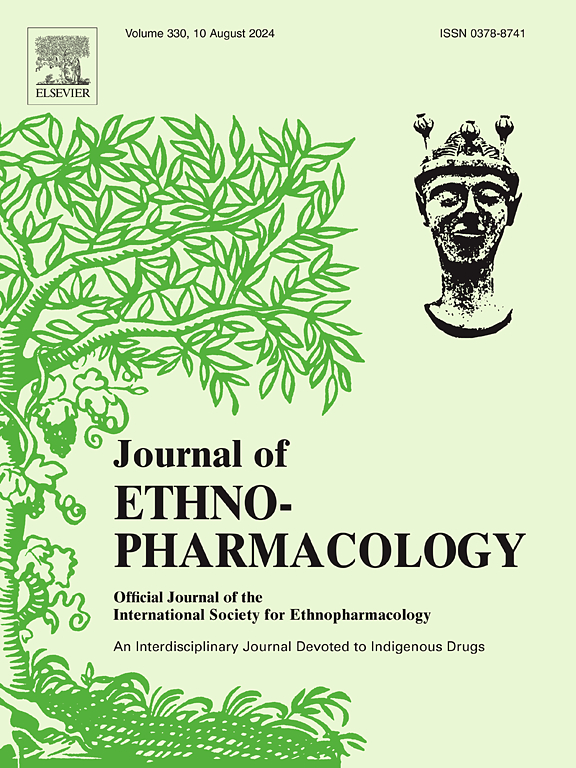Explore the key targets and mechanism of Danggui Buxue decoction against ulcerative colitis: Network pharmacology and experimental validation
IF 5.4
2区 医学
Q1 CHEMISTRY, MEDICINAL
引用次数: 0
Abstract
Ethnopharmacological relevance
The traditional Chinese herbal formula, Danggui Buxue decoction (DBD), is known for its ability in tonifying Qi and promoting the production of blood. It is extensively utilized in treating menstrual anemia and chronic non-healing ulcers. Whereas the impact of DBD on ulcerative colitis (UC) has not been explored, and its therapeutic mechanisms are not well comprehended.
Aim of the study
The research sought to investigate the impacts and mechanisms of DBD on UC through a blend of network pharmacology and experimental confirmation.
Materials and methods
A network pharmacology approach was utilized to predict DBD's potential mechanisms of action on UC, which were then validated through experimental studies using a dextran sulfate sodium (DSS)-induced UC mouse model to assess its protective effects on intestinal injury. Western blot analysis was conducted to examine changes in protein expression within the primary pathway affected by DBD.
Results
A total of 27 active chemical components, 265 potential targets, and 5867 UC target genes were identified through screening. Of these, 172 common targets were found between DBD and UC. Additionally, 2359 GO biological process items and 157 KEGG signal pathways were identified through analysis. Molecular docking revealed strong binding ability between the main compounds and target proteins. In the DSS-induced UC mouse model, DBD reduced intestinal inflammation and attenuated colonic pathological damage, which is associated with DBD's inhibition of the PI3K/AKT pathway.
Conclusions
DBD significantly attenuates colonic inflammation and preserves the integrity of the intestinal mucosa. Furthermore, the anti-UC efficacy of DBD is intricately linked to the suppression of the PI3K/AKT pathway.

探讨当归补血汤治疗溃疡性结肠炎的关键靶点及作用机制:网络药理学及实验验证
民族药理学相关性当归补血汤(DBD)是一种传统的中草药配方,以其补气活血的能力而闻名。它被广泛用于治疗经期贫血和慢性不愈合溃疡。然而,DBD对溃疡性结肠炎(UC)的影响尚未被探索,其治疗机制尚未得到很好的理解。本研究旨在通过网络药理学和实验验证相结合的方法探讨DBD对UC的影响及其机制。材料与方法采用网络药理学方法预测DBD对UC的潜在作用机制,并通过葡聚糖硫酸钠(DSS)诱导UC小鼠模型的实验研究来验证DBD对肠道损伤的保护作用。Western blot分析检测DBD影响的主要通路内蛋白表达的变化。结果共鉴定出27种有效化学成分,265种潜在靶点,5867种UC靶基因。其中,在DBD和UC之间发现了172个共同目标。此外,通过分析确定了2359个GO生物过程项目和157个KEGG信号通路。分子对接显示主要化合物与靶蛋白之间具有较强的结合能力。在dss诱导的UC小鼠模型中,DBD可减轻肠道炎症,减轻结肠病理损伤,这与DBD抑制PI3K/AKT通路有关。结论dbd能明显减轻结肠炎症,保持肠黏膜的完整性。此外,DBD的抗uc功效与抑制PI3K/AKT通路密切相关。
本文章由计算机程序翻译,如有差异,请以英文原文为准。
求助全文
约1分钟内获得全文
求助全文
来源期刊

Journal of ethnopharmacology
医学-全科医学与补充医学
CiteScore
10.30
自引率
5.60%
发文量
967
审稿时长
77 days
期刊介绍:
The Journal of Ethnopharmacology is dedicated to the exchange of information and understandings about people''s use of plants, fungi, animals, microorganisms and minerals and their biological and pharmacological effects based on the principles established through international conventions. Early people confronted with illness and disease, discovered a wealth of useful therapeutic agents in the plant and animal kingdoms. The empirical knowledge of these medicinal substances and their toxic potential was passed on by oral tradition and sometimes recorded in herbals and other texts on materia medica. Many valuable drugs of today (e.g., atropine, ephedrine, tubocurarine, digoxin, reserpine) came into use through the study of indigenous remedies. Chemists continue to use plant-derived drugs (e.g., morphine, taxol, physostigmine, quinidine, emetine) as prototypes in their attempts to develop more effective and less toxic medicinals.
 求助内容:
求助内容: 应助结果提醒方式:
应助结果提醒方式:


